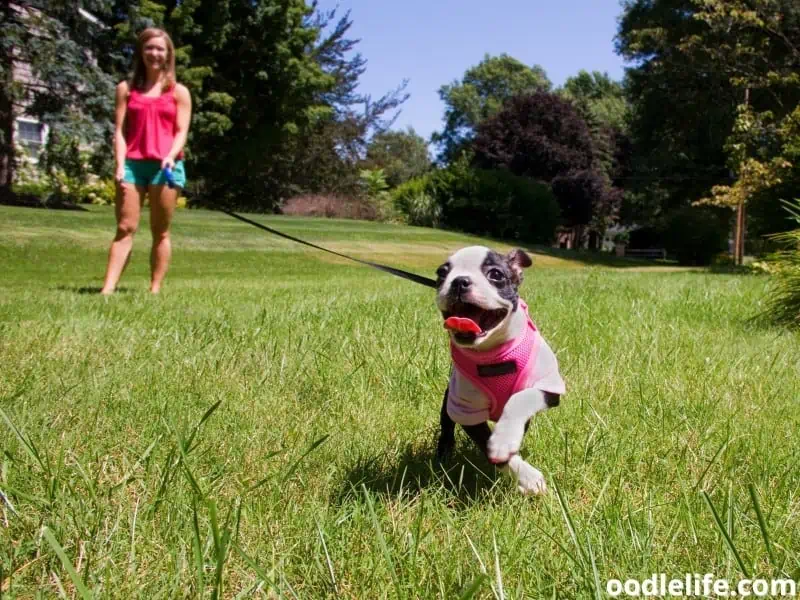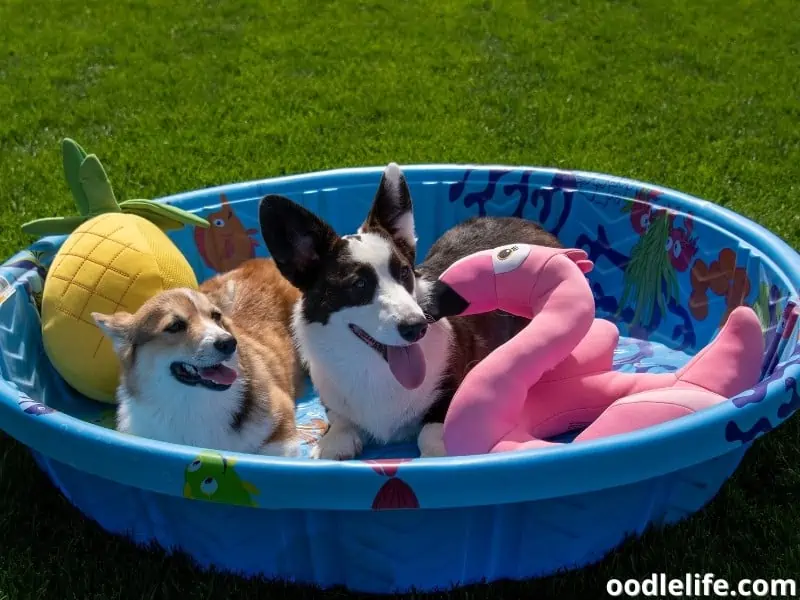How Much Playtime Do Puppies Need?
Whether you just brought home a puppy or your dog gave birth to a litter, it’s always an exciting time. And you’re undoubtedly eager to start playing with these cute fur balls.
However, being the concerned puppy owner you are, it might get you wondering—how much playtime does a puppy need?

The amount of playtime puppies need varies according to their age and breed, among other factors. So, I’ll help you understand how to determine how much exercise you should be giving your puppy and the dangers of going overboard on playtime.
Why There Isn’t a Set Rule for How Much Playtime a Puppy Needs?
The reason it’s so hard to know how much playtime puppies need is that it depends on several factors, including:
- Age
- Breed
- Gender
- Individual growth
For example, a puppy that’s a day old won’t be able to do more than lay beside its mother, while a six-month-old puppy will be ready to play fetch.
It’s also essential to assess each puppy’s ability within the litter. For example, although not all litters contain a runt, a runt puppy won’t have the same exercise needs as its larger and healthier siblings.

A General Rule of Thumb
Although there isn’t a set answer to the question, “How much playtime does a puppy need?” There’s a five-minute rule to give you some guidance.
The rule goes as follows: Your puppy can have five minutes of playtime per month of age.
So, if your puppy is three months old, 15 minutes of exercise per day is a general recommendation.
However, I encourage you to follow your vet’s advice on how much exercise your puppy needs as they age. In addition, you should factor in common sense—if your puppy appears to be straining after an exercise session, it’s crucial to back off on how much exercise you give them.

Breaking Up Playtime
Another critical factor in determining the amount of daily playtime your puppy should have is understanding that you should break up the playtime into several different sessions.
So, going back to the 5-minute rule above, if you have a three-month-old puppy that requires 15 minutes of daily playtime, you shouldn’t play with them in a straight 15-minute session.
Instead, it’s crucial to break up that time into at least three daily play sessions. That way, your puppy will have plenty of time to rest, and you’ll give them opportunities for more entertainment throughout the day.

The Dangers of Over-Exercising a Puppy
In most cases, people tend to over-exercise their puppies instead of under-exercising them. After all, puppies are adorable, and playing with them doesn’t usually take as much work as heading out to the backyard to play a game of hard-core tug-of-war with a full-grown dog.
However, it takes an average of 14 months for a puppy’s growth plates to fully close. During this time, their bones have a higher chance of injury and deformations from over exercising.
That said, some puppies grow until 24 months old, especially larger dog breeds like Mastiffs. But the good news is that most large dog breeds stop growing between 12 to 18 months old.
So, it’s crucial to monitor your dog for signs of overexertion.
Your puppy only has two places where its legs grow from growth plates. These growth plates are extraordinarily soft and flexible before they harden, producing new tissue that will eventually calcify once your puppy reaches its full size.

When To Play With Your Puppy?
I don’t recommend waking up your puppy from a nap to play with them. Sleep is crucial to puppies as it helps them develop their central nervous system, muscles, and brain function.
Ideally, you should play with your puppy when they’re already awake and showing signs of high energy, such as playing with their littermates.
Otherwise, any waking hour is fine to play with them as long as they haven’t eaten in the past one hour. Doing so can cause your puppy stomach discomfort and even gastric dilation and volvulus (canine bloat).
Puppies love having a schedule. So when possible, it’s ideal for playing with them around the same time every day. And remember, you’ll need to break up their playtime into multiple sessions, so in a perfect world, each one should be at a similar time.

Play Options for Puppies
The type of playing you do with your puppy will depend on their age. When your puppy is less than one month old, their version of playing will primarily be rolling on the floor while they bat a toy you dangle in front of them.
As your puppy ages, varying the type of play you do becomes crucial to challenging them and keeping playtime interesting.
Tug-of-war, fetch, and taking short walks are all excellent options for playtime.
Regardless of the types of play styles that you incorporate into your puppy’s routine, try to keep the amount of agility involved to a minimum until their growth plates harden.

When Is It Safe To Run With a Puppy?
Running—and even jogging—can have a detrimental impact on your puppy’s growth plates. For this reason, many veterinarians recommend avoiding prolonged activities like jogging and running until your dog is 14 to 18 months old.
I understand that it seems like a long time to wait. But trust us, it’s not worth the risk of damaging your puppy’s growth plates.
The growth plate damage potential exponentially increases if you do a prolonged activity like running with your dog before they reach the proper age and do so on a hard surface like pavement.
So, once your puppy is old enough, walking them ¼ of a mile or less on gentler surfaces like the grass is the ideal option.

When Is It Safe for a Puppy To Play Outdoors?
It’s safe for a puppy to play outdoors without restrictions once they receive their complete set of vaccinations, typically when they’re 16 weeks old.
It can seem like a painfully long time to deprive your pet of fresh air, but it’s necessary—deadly diseases like canine parvovirus abound.
The good news is that if you use some precautions, you can play with your puppy outside in a contained environment.
For starters, you must ensure that your puppy won’t come in contact with any dog that hasn’t received its full set of vaccinations. Furthermore, you must ensure they don’t smell or eat animal poop.
Puppies undergo a critical stage between nine to 14 weeks old when they should socialize with other people and dogs for healthy development. Therefore, if you don’t have another dog at home, it’s wise to invite a vaccinated dog to your home so your puppy can interact with them.

Keeping Your Puppy Safe During Play
You now know that puppies are prone to growth plate injuries. But that’s not the only thing that can harm them when they play.
Like human babies, puppies need to learn right from wrong by playing and exploring the world. So, slippery surfaces, sharp objects, and playing in weather that’s too hot or cold can all cause them harm.
When choosing the best dog toys for your puppy, you’ll want semi-soft toys that fit partially—but not fully—in their mouth. Toys with removable parts, such as eyeballs, aren’t ideal for puppies, as they create a choking hazard.
Naturally, the toys you give your puppy will change as they age. Most notably, you’ll need to buy larger ones to ensure they don’t choke on the now smaller toys as their mouths get bigger.

Balancing Play With Alone Time
Even though you might want to be with your puppy 24/7, the reality is that life requires most people to leave their houses. And chances are, you can’t take your puppy with you every time.
So, you’ll be doing a service to your puppy by giving them a balance of playtime, cuddle time, and alone time. That way, you’ll decrease their chances of developing a separation anxiety disorder, affecting about 14% of dogs.

The Bottom Line
So, how much playtime does a puppy need?
The answer is “it depends,” which I know isn’t ideal.
Aside from using the five-minute rule as a general guide, I recommend following your veterinarian’s advice and monitoring your puppy for their personal abilities.
Above all, hold yourself back from playing with your puppy more than the recommended amount. I know it can be challenging, but it’s worth it so your puppy can grow into a healthy and well-developed dog.